First Dynasty - 3100 - 2890 BC
Menes was an Egyptian pharaoh of the First dynasty, to some authors the founder of this dynasty, to others the Second. He lived ca. 3100-3000 BC, but according to some lists, ca. 3050 BC.
Ancient Egyptian legend credits a pharaoh by this name with uniting Upper and Lower Egypt into one kingdom.
Manetho, a 3rd century BC Egyptian historian, called him Menes; the 5th century BC Greek historian Herodotus referred to him as Min; and two native-king lists of the 19th dynasty (13th century BC) call him Meni.
However, the discovery of the Narmer Palette in the late 19th century showing the pharaoh Narmer, possibly pre-dating Menes, wielding the unified symbols of both Upper and Lower Egypt has caused some controversy.
Some Egyptologists hold that Narmer and Menes are in fact the same person; others hold that Menes inherited an already-unified kingdom from Narmer; still others hold that Menes completed a process of unification started either unsuccessfully or only partially successfully by Narmer.
In either case, Menes is credited with the foundation of Memphis, which he established as the Egyptian capital.
It should be noted that while there is extensive archeological evidence of there being a pharaoh named Narmer, so far there is no contemporaneous archeological evidence for a pharaoh called Menes. The growing academic consensus is that Menes either refers to Narmer or, more likely, to his successor, Hor-Aha.
Another name for Menes has various spellings: Hor Aka, Hor-Aka, and Hor-Aha; Hor-Aka can be translated as "Horus of the Reeds", possibly in allusion to the legend in which Isis hid Horus in the Nile Delta among papyri and reeds.
In Ancient Egyptian legend, there was a battle between Horus (a patron deity of Lower Egypt) and Set (patron deity of Upper Egypt).
In this mythological unification of the two Egypts, Set was defeated and the kingdom was unified under the rule of Horus, the first king of all Egypt. It is possible that this war was transformed over time into myth.
A much later parallel can be found leading to the establishment of the reign of Pharaoh Khasekhemwy several hundred years later; he crushed a civil war between the followers of Set and Horus.
According to Manetho, Menes reigned 62 years and was killed by a hippopotamus.
Reference: Kinnaer, Jacques. What is Really Known About the Narmer Palette? KMT: A Modern Journal of Ancient Egypt, Spring 2004.
Hippopotamus myths and metaphors:
- The Hippopotamus lives both underwater and above ground. Water is associated with the collective unconsciousness. The hippopotamus is amphibious. To be killed by a hippopotamus is to return to the source of creation.
Taweret Goddess depicted as a pregnant hippo
Djer is the second Egyptian king of the first dynasty. He was the son of Menes and one of his lesser ranked wives, a woman named Hent.
Manetho gives him the name Athothis, or Atoti. Almost nothing is known about the life of Djer.
His name was found in an inscription on the Wadi Halfa, south of the first Cataract, proving the boundaries of his reign.
Heiroglyphs on Ivory and wood labels from Abydos and Saqqara say he reigned for 57 years.
According to Manetho, he reigned 57 years, but according to modern research (Von Beckerath's Chronologie des pharaonischen Agypten) his reign lasted only two years (3000 BC-2999 BC).
He probably fought several battles against the Libyans in the Nile delta.
Djer's wife was Queen Herneith.
Like his predecessor, Hor-Aha, he was buried in the holy place Abydos. Close to his grave is another, that probably belongs to his wife Herneith, mother of the later king Den, and possibly his regent during his youth.
From the Eighteenth dynasty, his tomb was revered as the Tomb of Osiris.
The evidence for Djer's existence:
- a tomb in Umm el-Qa'ab, Abydos;
- seal prints from graves 2185 and 3471 in Saqqara;
- inscriptions in graves 3503, 3506 and 3035 in Saqqara
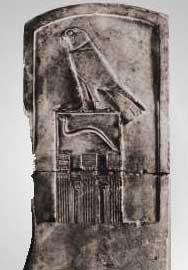
Horus (hawk) name of Wadj
snake over palace facade
Djet, also known as Wadj, Zet and Uadji (in Greek possibly the king known as Uenephes), ca. 2920 BC, was the third Egyptian king of the first dynasty. His name means serpent.
Little is known about his reign, but he has become famous because of his tomb stela. It is decorated with Djet's Horus name, and shows that the distinct Egyptian style had already become fully developed.
His stela is displayed at the Louvre in Paris. It is made of limestone carved by the sculptor Serekh. The stela was discovered near the ancient city of Abydos where Wadj's mortuary complex is located. The only other place that Egyptologists found a reference to him was in an inscription near the city of Edfu, to the south of Egypt.
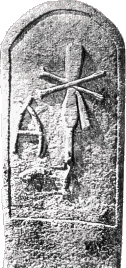
His wife was Queen Mereneith, who acted as mentor and advisor for his son and successor, King Den. Queen Merenith ruled Egypt as regent when Den became king as a child. This essentially meant that she ruled Egypt until he was capable of doing so himself.There are, many scholars who think that Merenith was a ruler in her own right. Stone vessels and sealings bearing her name were found at Saqqara, as was a stela with her name written inan archaic form with crossed arrows signifying the name of Neith. Merenith has two burial sites, one at Abydos and one at Saqqara (Mastaba 3503). The Saqqara tomb contains some artifacts that show the the name of a high court official called Seshemka. The Abydos burial complex is amongst those of the kings of her dynasty. A stela had her name blended with royal emblems, as did her coffin.
Den (or Dewen) was the fourth Egyptian king of the First Dynasty. He ruled Egypt for almost fifty years after Wadj.
He was an energetic and athletic person, and was known to have been artistic.
Annals mention battles against Bedouin tribes in the Sinai during his reign, which was justified by his interest in protecting the mineral resources of the peninsula.
The cult of Apis was introduced during his reign.
He figures in the Ebers papyrus as well as the Berlin medical Papyrus.
He was the first to use the title King of Upper and Lower Egypt and the first to wear the double crown.
He was buried at Saqqara, even though he built his mortuary complex in Abydos. The floor of his tomb in Umm el-Qa'ab at Abydos is made of red granite, the first time in Egypt this hard stone was used as a building material.
Anedjib was the fifth king of the first dynasty. He was also known as Enezib or Andjyeb.
He kept Memphis as his capitol city throughout his approximate 14 years of rule, as the exact number of years remains unknown.
Anedjib's crown carried the symbols of both Upper and Lower Egypt, a representation of the unification of the country under his power. Historians, however, doubt that Anedjib really controlled the north, due to the fact that the northern Nomes rebelled against him constantly throughout his reign.
His wife, Queen Betrest, was the mother of King Semerkhet, who was his successor. The queen provided Anedjib with legitimacy and power since she was a descendant from the Memphite royal line.
Order broke down during his reign when conflicting factions caused changes that would end this great dynasty.
Anedjib built a tomb (Tomb X) at Abydos, but it is one of the worst built and smallest of the Abydos royal tombs, measuring a mere 16.4 x 9 meters (53 3.4 x 29 1/2 feet). Interestingly, the burial chamber was constructed entirely of wood, and there were 64 graves of retainers within the area, also of low grade construction.
Another tomb which was apparently built during the reign of Anedjib is that of an official named Nebitka (tomb 3038 at Saqqara). This tomb is interesting in that it contained a mudbrick stepped structure inside the Mastaba like structure, that some Egyptologists see as a forerunner of Djoser's Step Pyramid.
Other than his tomb at Abydos, Anedjib is also attested to by seal impressions in tomb 3038 (the tomb of Nebetka) at Saqqara, in a tomb at Helwan, and also in a tomb at Abu Rawash.
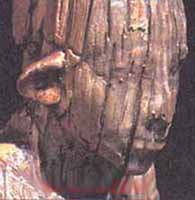
According to the limited information on Semerkhet, the traditional 6th king of Egypt's 1st Dynasty. He was the son of King Anedjib and Queen Betrest. The Palermo Stone says he ruled Egypt for about nine years. Manetho records his reign as 18 years, and notes that there were numerous disaster during his reign. This is probably due to the problems with his succession and predecessor, as it has been suggested that Semerkhet usurped the throne.
He destroyed the name of his predecessor, Anedjib, on a number of stone vessels, and it would seem in return, was himself omitted from the Saqqara King list.
Semerkhet was the king's Horus name, and means "Thoughtful Friend" (though Nicolas Grimal in A History of Ancient Egypt disagrees, stating that the Horus name means "companion of the gods". Grimal also tells us that his nebty name meant "he whom the two mistresses guard", a reference to Nekhbet, the vulture goddess of Nekheb (el-Kab), and Wadjet, the serpent-goddess of Pe and Dep (Buto). Grimal therefore suggests that he may have had a priestly role prior to his ascending the throne of Egypt.
His tomb is located at Abydos (Tomb U). It measures 29 x 31 meters (95 x 101 3/4 feet), which makes it considerably larger then that of his predecessor. It is also of superior quality to Anedjib's tomb. Semerkhet's tomb has a brick lined burial chamber and is surrounded by well built servants' graves. Petrie investigated Semerkhet's tomb at Abydos, and found the entrance ramp saturated up to "three feet" deep with aromatic oil, which, after some 5,000 years, still permeated the entire tomb with scent. Archaeologists have not discovered a mastaba tomb from his reign at North Saqqara, though his predecessors seem to have mostly built tombs there as well.
Most scholars believe that Qa'a was the last king of the 1st dynasty. We may also see his name as Kaa, or several other variations. Though Egyptologists often disagree on dating, our current best guess is that he lived from about 3100 to 2890 BC.
According to Manetho he reigned for about 26 years.
Information on Qa'a is limited. He is mentioned on jar sealings and two damaged stela. One one of these stela he is shown wearing the White Crown of Upper Egypt and being embraced by the God Horus.
Egyptologists have also discovered the stelae of two of Qa'a's officials, Merka and Sabef. These stelae have more complex inscriptions then earlier hieroglyphics, and may have signaled in increasing sophistication in the use of this writing.
He was probably buried in Tomb Q at Abydos, where two typical royal funerary stelae bearing his name were found on the east side of the tomb. This tomb has been excavated on a number of different occations, first by Emile Amelineau in the 1890s, then Flinders Petrie and in 1991, by Gunther Dreyer and Werner Kaiser.
The work done by this later German team revealed many small artifacts and architectural details that had been overlooked by earlier excavations. These include thirty inscribed labels that describe the delivery of oil, probably made from berries or tree resins, and probably from the Syria-Palestine area.
Seal impressions and artifacts have also been discovered in Tomb Q with the name of Hetepsekhemwy, the first pharaoh of the second dynasty. This suggests that Hetepsekhemwy completed Tomb Q, and that there was no real break between the first and second dynasties of Egypt. The change in dynasties from the first to the second was originally reported by Manetho without explanation.
We also know about four tombs in Saqqara that date to this kings reign. The lower part of two wooden statues were found in one of these tombs in a set of rooms on the north side. Some scholars believe this may have been an offering chapel, and that the mortuary temple in pyramid complexes may have evolved from this structure.
The pharaoh with a bird within his serek is known from only one piece of evidence, and that comes from the galleries under the step pyramid from third dynasty king Djoser at Sakkara.
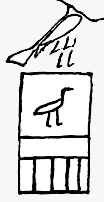
This object is from a stone vessel made of schist with this king's name carved in.
His position is far from certain, but he is considered to have had a short reign at the end of the second dynasty. This estimation is made by comparing his hieroglyphs' and serek's form to those of other rulers at the time. One of them is a crude serek found in king Qáa's tomb at Abydos in 1902 and possibly showing a bird.

This bird looks like a stork with a long body and neck and a rather short nib, possibly a heron and the picture left shows a similar hieroglyph. His position in the sequence of kings during this rather unknown period is hard to establish with certainty.
He must not be confused with the Horus Ba from the third dynasty whose serek had a human bone, in one occasion together with an ram. (The phonetic sounds in Egyptian is similar in these names).
The reason for placing him after Qáa is mainly the epigraphically similarities (the form of the serek) and a seal from his tomb shows the seven first rulers from the first dynasty in a successive line without mentioning a king called "Bird". Accompanying text from the scanty remains of the Bird Pharaoh is almost identical to some of Qáa's, making it very likely to place him just in this era.
This ephemeral pharaoh belongs to the very end of the first dynasty, a period that obviously was a time of some instability in society. His name is only attested twice - both from finds in Sakkara.
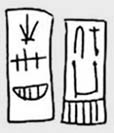
This is a fragment of schist found by British archaeologist Walter Emery in the debris at the escarpment north of King Djoser's funeral complex, when he was excavating mastabas from the first dynasty. (Emery: Great Tombs III, pl. 38.1).

The serek contains the three hieroglyphs making up the king's name, but in a slightly different order than in the other remain from his existence - a stone vessel found under the pyramid of king Djoser and published by Egyptologist Kaplony in MDAIK in 1988. His name is not recorded in any of the kings' lists made during the further 2,500 years the Egyptian state should exist. This can mean that he was a probably unknown to later generations due to the fact that his reign was a very short and insignificant one and the remains were very few. That's the reason why his position - together with Pharaoh Bird - cannot be established with certainty.
References:
- Monarchs of the Nile Aidan Dodson, 1995
- History of Ancient Egypt A Grimal, Nicolas, 1988
- Oxford History of Ancient Egypt Ian Shaw, 2000
- Wikipedia
- Egypt Tour Website
No comments:
Post a Comment